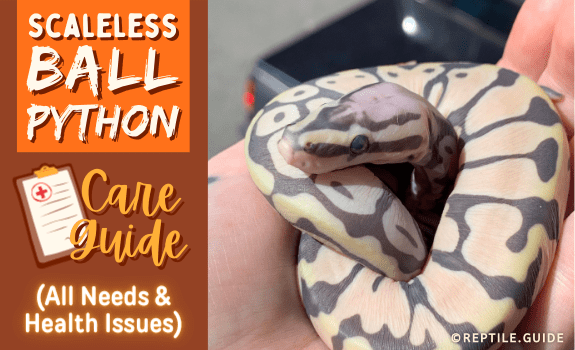Ball pythons (Python regius) are the most popular snakes kept as pets, but have you ever heard of a scaleless ball python?
Scaleless ball pythons are one of the rarest ball python morphs on the market.
Their care is essentially the same as other ball pythons, but with slight differences.
The skin of a scaleless ball python is more sensitive than other snakes. They need softer bedding, may have issues shedding, and require different temperature parameters.
Because of their slightly more advanced care requirements, we don’t recommend them as beginner snakes like other ball pythons.
In this guide, we answer all your scaleless ball python care-related questions, including:
- Are scaleless ball pythons healthy?
- What do scaleless ball pythons eat?
- Where can I buy a scaleless ball python?
- How much does a scaleless ball python cost?
- How do I set up a scaleless ball python enclosure?
In This Article
Where to Buy a Scaleless Ball Python
A scaleless ball python may be challenging to find. They’re still rare and controversial.
Your best options for buying a scaleless ball python are:
| Breeders |
You can connect with breeders through online forums or directly from their websites. You can usually purchase your snake online and have it shipped to you, or find a local breeder to meet in person. |
| Online Marketplaces |
Marketplaces like MorphMarket are good ways to get in touch with breeders. You can message sellers directly and see detailed ratings left by previous buyers. MorphMarket allows you to search for the exact snake you have in mind and ship it right to your door without ever leaving your couch! They also have policies and guarantees in place to protect buyers and sellers. |
| Reptile Expos, Conventions, and Shows |
You can meet reptile breeders at shows and conventions, like Repticon, all over the county. This option allows you to talk to the breeder face-to-face and see the snake before purchasing it. Reptile shows are great ways to explore all the ball python varieties, and they’re often cheaper than purchasing online. |
Purchasing reptiles in-person has a lot of advantages.
You’ll get the chance to look the animal over, make sure it’s healthy, assess the breeder, and you don’t have to pay shipping fees or worry about your snake arriving safely.
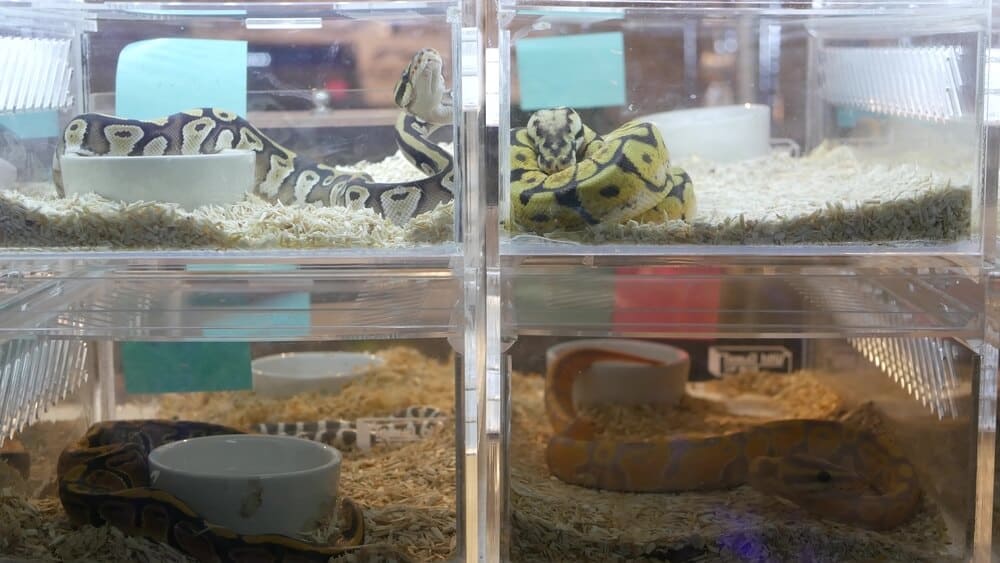
Contacting breeders directly or meeting in person will allow you to ask them plenty of questions about the snake’s history. They can also give you advice about caring for these unique reptiles.
Note that a completely scaleless ball python may be referred to as a ‘super scaleless head’ ball python in places like MorphMarket.
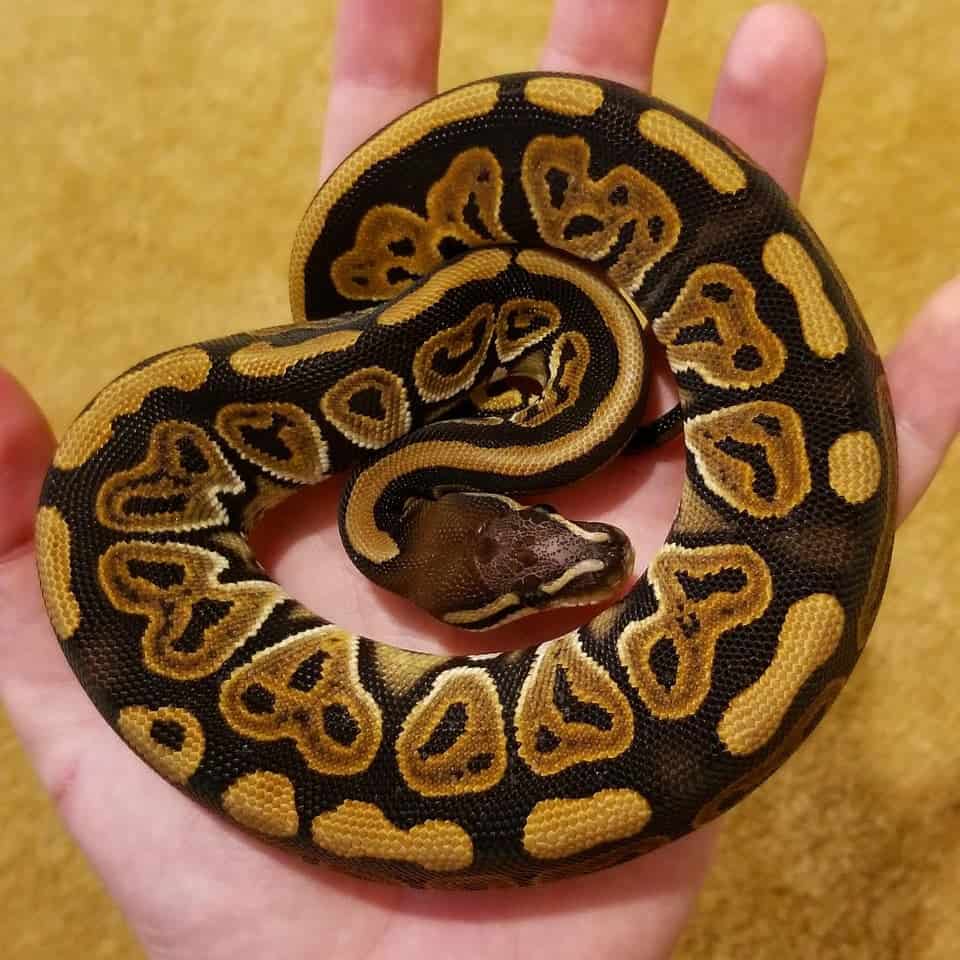
Image credit u/ItzDaSkellz (via Reddit.com)
You’ll find plenty of scaleless head ball pythons for sale. The only scales they’re missing are patches on top of their heads.
How Much Does a Scaleless Ball Python Cost?
Several factors influence the price of a ball python:
- Age – Older individuals typically cost more.
- Sex – Females are more expensive than males.
- Genetics – Valuable breeders and strong genetic lines are more expensive.
- Appearance – Price fluctuates greatly depending on the color, pattern, and morph.
A fully scaleless ball python costs $1,000 and up.
They still cost significantly less than when they first appeared on the market.
Breeders create more expensive designer morphs by breeding a scaleless ball python with another type of morph.
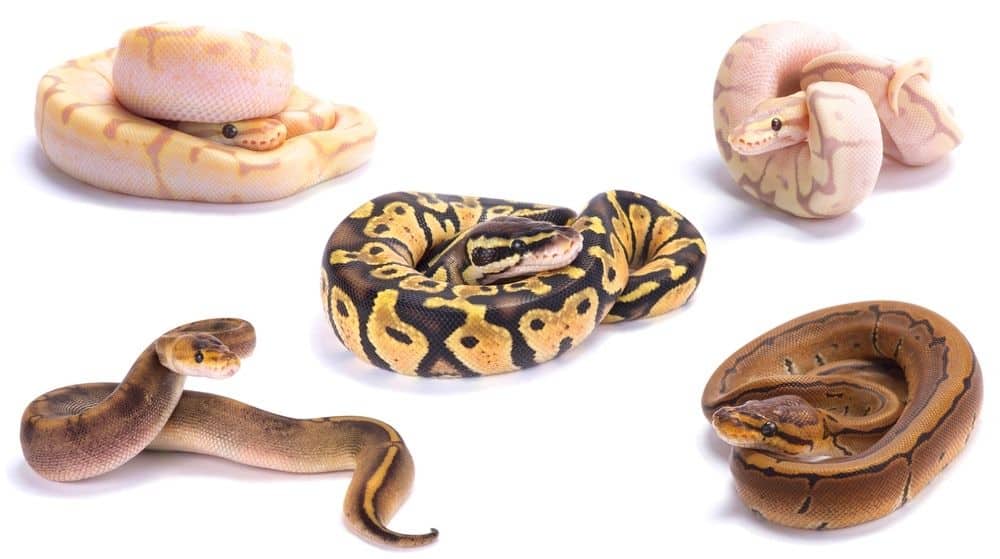
Wildtypes are the cheapest scaleless morph because it’s the most common coloration.
Scaleless head ball pythons range from $100 to $1,000. The same factors affect scaleless head ball python prices.
Fun Fact: Someone offered an astounding $125,000 for one of the first completely scaleless ball python babies.
Choosing a Scaleless Ball Python
If you’re going to spend $1,000+ on a snake, you want to make sure it’s a good investment.
A few key questions you should ask the breeder:
- How old is it? Good breeders will have detailed records with hatch dates.
- Is it in good health? You want a snake that looks bright and alert. Look for mites, burns, lacerations, and signs of respiratory problems, like bubbling at the mouth or wheezing.
- What has it been eating? You typically want to continue feeding your new snake what it’s used to eating. It’s best if they’re already eating frozen-thawed prey.
- Has it been eating reliably? You don’t want a snake that refuses to eat.
- Has it been handled regularly? Knowing the snake’s temperament gives you an idea of how much work you’ll need to put into it. There’s a good chance the snake is more docile if the breeder has been handling it.
Buying online can be challenging. Ask the breeder just as many questions, if not more, and ask for pictures.
The best practice is to get the breeder’s information and do your research beforehand.
Check online forums and reviews to see what others say about the breeder. Are they credible? Have others had good experiences with them?
Your new companion will be with you for many years. Finding the right one will set you up for success in the long run.
Scaleless Ball Python Enclosure
Scaleless ball python enclosure setup varies slightly from a normal ball python enclosure.
You’ll need to keep their sensitive skin in mind when creating their new habitat.
When looking for the perfect enclosure, you’ll want to consider these factors:
- Size
- Price
- Material
- Security
- Ventilation
We discuss the specifics below.
Enclosure Size
Scaleless ball pythons have the same enclosure size requirements as regular ball pythons.
The size of your enclosure will need to grow with the snake. At each stage, you’ll need one that is longer than it is tall.
A juvenile ball python is happiest in a 10-gallon setup. This is equivalent to a 20″x10″x12″ tank.
As your snake matures, you can upgrade them to a 20-gallon enclosure, or 24″x12″x16″.
40-gallon or 48″x12″x16″ enclosures are suitable for a fully grown ball python.
They can live in larger enclosures as long as you maintain a proper temperature gradient and provide enough hiding areas for your snake to feel comfortable.
Type of Enclosure
The most common types of ball python enclosures include:
| Wood |
Wood enclosures retain heat and humidity, are attractive, and provide more cover than all-glass enclosures. Wood enclosures can rot from prolonged exposure to high humidity levels and are porous and hard to clean. |
| Glass |
Glass enclosures are durable, easy to clean, and give you the most visibility of your snake. They don’t hold temperature and humidity well, and your snake might feel exposed by having transparent walls on all sides. You may need to make modifications to the tank, like partially covering the walls or insulating the enclosure to help your snake feel comfortable. |
| PVC/HDPE |
Polyvinyl Chloride (PVC) and high-density polyethylene (HDPE) enclosures are our top choice. They’re durable, water-resistant, safe, and retain heat. You can purchase made-to-order PVC/HDPE enclosures or have one custom-made for your scaleless ball python at Custom Reptile Enclosures. |
| Plastic Tubs |
Plastic storage tubs are the cheapest option. They’re customizable, easy to clean, offer your snake more privacy, and maintain temperature and humidity levels. You’ll have to modify the tubs to suit your snake’s needs and make sure the material is appropriate to use with heating elements. The use of tubs as enclosures is a topic of debate in the reptile community. They’re best as short-term housing solutions. |
If you’re crafty and up for a challenge, try building your enclosure!
Lighting
Scaleless ball pythons don’t require special lighting.
Use lighting that doesn’t increase the temperature of the enclosure.
Timers will help keep your snake on a clear day/night cycle. They should have 12 hours of darkness each day.
Temperature and Humidity
Scaleless snakes can be more sensitive to temperature and humidity levels.
You’ll need to create a temperature gradient in your snake’s enclosure.
The cool side should be 75-80°. Never let the temperature drop below 75°.
Keep the warm side between 84-89°.
One end of the enclosure should be a basking area of 90-94°.
Keep an eye on where your snake spends most of its time. You may need to adjust your temperature parameters based on their behavior.
The best way to maintain these temperatures is by using heating pads with thermostats.
You can also use heat tape and ceramic heat emitters if you’re having trouble keeping temperatures in range.
Ceramic heat emitters can dry out the air, so you’ll need to be extra vigilant about humidity levels when using one.
Make sure your snake can’t touch any heat sources directly. They can cause severe burns.
Place thermometers at both ends of the enclosure to monitor temperatures on each side of the gradient.
Your scaleless ball python will do best with humidity levels between 50-70%.
They’re more susceptible to dry skin, so higher humidity levels are crucial.
The best ways to increase humidity levels in your enclosure:
- Keep the enclosure warm.
- Install a fogger or humidifier.
- Use large shallow water bowls.
- Mist your enclosure once a day.
- Use a substrate that retains moisture.
- Make sure your tank isn’t too ventilated.
Place a hygrometer in your enclosure to monitor humidity levels. You can find hygrometer/thermometer combos that take care of both needs.
Take a look at our ball python temperature and humidity guide for more in-depth information.
Substrate
Substrate options are more limited for fully scaleless ball pythons.
Unlike other scaleless snakes, ball pythons don’t have ventral scales to protect their bellies.
You’ll need a substrate that isn’t abrasive against their more vulnerable skin.
The best substrate options for your scaleless ball python include:
| Paper Towels | Paper towels are the cheapest option and easiest to maintain. Unfortunately, paper towels don’t allow your snake to burrow and won’t help retain humidity. |
| Soil Mixtures |
A mix of organic topsoil, sand, peat moss, and coconut fiber. Pros of soil mixtures:
You can buy ready-made bags like ReptiSoil, or make your mixture. The soil you’re using needs to be pesticide and fertilizer-free. Turn the soil every few days to aerate it and avoid mold growth. |
| Coconut Fiber |
Pros of coconut fiber:
Coconut fiber can get messy, and like soil mixes, you’ll need to turn it frequently to avoid mold growth. |
You can use aspen shavings, but they won’t help with humidity and mold easily.
Cypress mulch is a popular substrate for ball pythons but is too rough for your scaleless ball python.
Never use pine or cedar shavings because they’re toxic to snakes.
Hides and Decor
Hides are the most crucial furniture for your ball python.
Provide at least two hides, one on the cool end and one on the warm end of the enclosure.
They should be large enough for your snake to fit its entire body inside.
Humid hides have several benefits for your snake. They provide shelter, increase humidity levels, and help your snake shed.
They can be as simple as a homemade plastic container or a store-bought hide if you’re looking for something more natural. Just add some sphagnum/peat moss and keep it damp, not wet.
Live plants make your python’s enclosure feel more natural with the bonus of helping maintain a humid environment.
Low vines, branches, and climbing structures allow your snake to exercise natural behaviors and fully utilize its temperature gradient.
The most important consideration is that everything in the enclosure is smooth.
Sand down sharp edges and anything that could potentially cut your snake.
We recommend visiting Chewy.com for all of your snake enclosure needs!
Scaleless Ball Python Diet
Scaleless ball pythons require the same diet and feeding schedule as regular ball pythons.
The only difference is that they should only be fed live prey as a last resort.
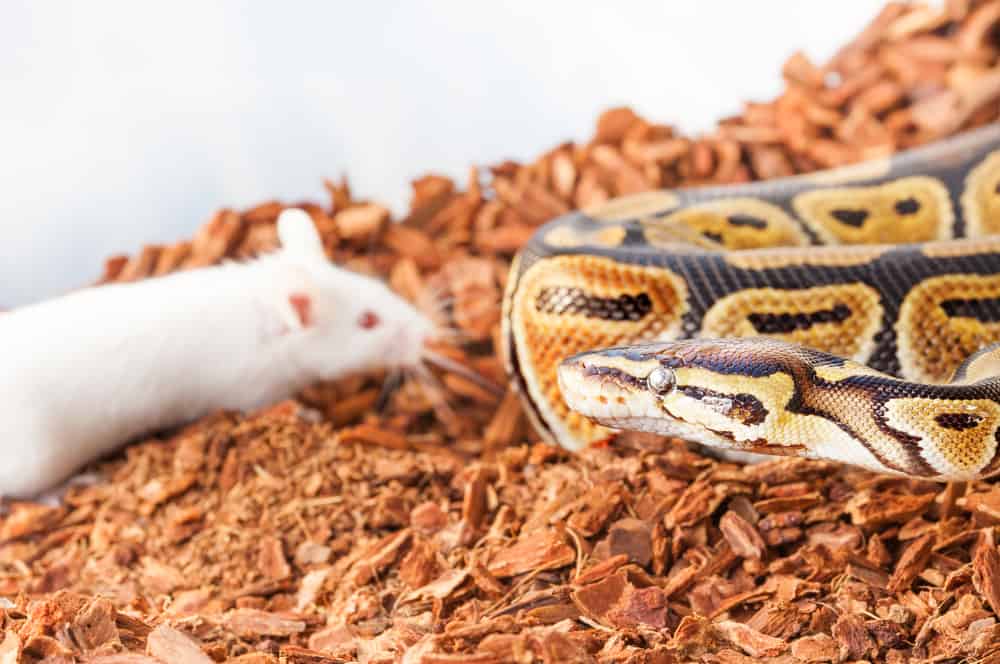
Live rodents can seriously injure your snake with their sharp teeth and nails.
Your best options are pre-killed or frozen-thawed mice and rats.
Check with the breeder you purchased your snake from to see which prey they were using and try to stick with that.
Ball pythons can be picky eaters and may not take prey they aren’t familiar with.
You can purchase frozen mice and rats in bulk online to save money.
Thaw frozen prey in warm water and offer it to your snake while it’s still warm.
Their prey should be no bigger than the widest part of your snake’s body.
Feeding schedules are based on age.
Juveniles need to eat once a week. Mice or rat pinkies, fuzzies, and hoppers are the best options for smaller snakes.
Adult ball pythons can eat adult mice or rats once every 10 to 14 days.
Offer prey using forceps to avoid your snake mistaking your hand for food.
Ball pythons are nocturnal by nature, so it’s best to feed your snake at night.
Avoid handling your snake 48 hours before and after feeding it to avoid stress and regurgitation.
Enclosure Maintenance
A well-maintained enclosure will help keep your scaleless ball python healthy.
Daily maintenance is simple. Change the water and check the substrate for urates every day.
Change paper towels daily, or turn substrates every few days to prevent mold growth.
Thoroughly sanitize the enclosure once a month.
You’ll need to remove your snake and place them in a secure location while you do a deep cleaning.
After they’re safe in a temporary home, remove all hides, decor, water bowls, and substrate.
Sanitize all sides of the enclosure and furniture.
Add fresh substrate and replace furniture.
Don’t be afraid to shuffle things around and switch out hides and decor.
Rearranging your python’s home can be mentally stimulating and provide environmental enrichment.
Just make sure there are still two hides on each end of the enclosure.
Scaleless Ball Python Health Issues
Take extra precautions with your scaleless ball python’s health.
Not only are they susceptible to health issues that are common in regular ball pythons, but their delicate skin also adds several complications.
The most common health concerns in scaleless ball pythons include:
| Wounds |
Scaleless snakes are more vulnerable to scratches and cuts. You’ll need to be extra cautious of any sharp edges in your snake’s enclosure. If you aren’t careful, open wounds can become infected. |
| Stomatitis |
Stomatitis, commonly referred to as mouth rot, is a bacterial infection of the mouth. Avoid mouth rot with an appropriate diet and good husbandry practices. Symptoms include:
|
|
Dysecdysis |
Scaleless snakes do shed, and sometimes they have a tough time doing it by themselves. Incomplete shedding, or dysecdysis, occurs more frequently in scaleless snakes. Their sheds tend to roll too tightly and get stuck in a ring about a third of the way down their bodies. You can help them finish shedding by gently cutting the rolled-up shed to loosen it. You can continue to unroll the shed if the skin is completely loosened from its body. It’s hard to prevent this from happening, but some keepers rub products like Bag Balm on their snake’s skin to keep it moisturized. Humid hides, baths, and raising humidity levels during a shed cycle can also help with dysecdysis. |
|
Dehydration |
There are conflicting opinions on whether scaleless snakes are more prone to dehydration than regular snakes. Proper temperature and humidity levels and a fresh drinking source will help avoid dehydration. |
|
Respiratory Infections |
All ball pythons are vulnerable to respiratory infections. Poor husbandry typically causes respiratory infections. Symptoms of respiratory infections in snakes include:
|
Most scaleless ball python health issues are a result of poor husbandry practices.
Diligently check temperature and humidity levels, keep your tank clean, and feed the proper diet to avoid a trip to the veterinarian.
Seek the advice of a qualified professional if you have serious concerns about your snake’s health.
Handling Your Scaleless Ball Python
The skin of a scaleless ball python is soft and smooth, making them pleasant to hold.
They have the same gentle dispositions as other ball pythons and are easy to handle.
With a regular handling routine, your snake will start to enjoy time out of its enclosure.
Resist handling your ball python for a few days after bringing it home.
Moving is stressful for any animal, and you’ll need to give it time to adjust to its new environment.
Start with short handling sessions and gradually increase the amount of time as your snake begins to feel more comfortable.
Your snake may ball up at first. Give it some time to adjust, and never try forcing it to uncoil.
Steps of handling your scaleless ball python:
- Remove jewelry or anything that can scratch their delicate skin.
- Wash your hands thoroughly.
- Move slowly, but don’t surprise your snake. Make sure it knows you’re there.
- It’s best not to approach from above. Scoop under its body from the side.
- Pick it up from the middle of its body. Avoid touching the head.
- Support your snake with both hands while allowing it to move freely in the safety of your arms.
- Gently lower it back into its enclosure.
- Wash your hands again!
Don’t keep your scaleless ball python out of its enclosure for too long so that it doesn’t get cold.
Overhandling often leads to stress. Only handle your snake two or three times a week.
It’s best to avoid handling a snake during its shed cycle. Sometimes you’ll need to pick up your scaleless ball python during this time to help it shed.
Avoid handling your snake for 48 hours before and after feeding to decrease the risk of regurgitation.
Remember that even though these are docile snakes, they can still bite, and accidents happen sometimes.
Scaleless Ball Python Background
The ball python, scientific name Python regius, is a smaller species of python native to Africa.
They grow to be between three to five feet long, and females are typically larger than males.
A scaleless ball python is just what its name suggests, a ball python without scales.
They’re sometimes referred to as “super scaleless” because there are many variations of scaleless snakes.
Some have scaleless heads, patches of scales missing on their bodies, or only have ventral scales.
A scaleless ball python’s only scales cover its eyes.
Snakes’ eye scales are essential. They’re called eye caps, or spectacles, and they have them in place of eyelids.
BHB Reptiles were the first to breed scaleless ball pythons. They were created by breeding two scaleless head ball pythons together.
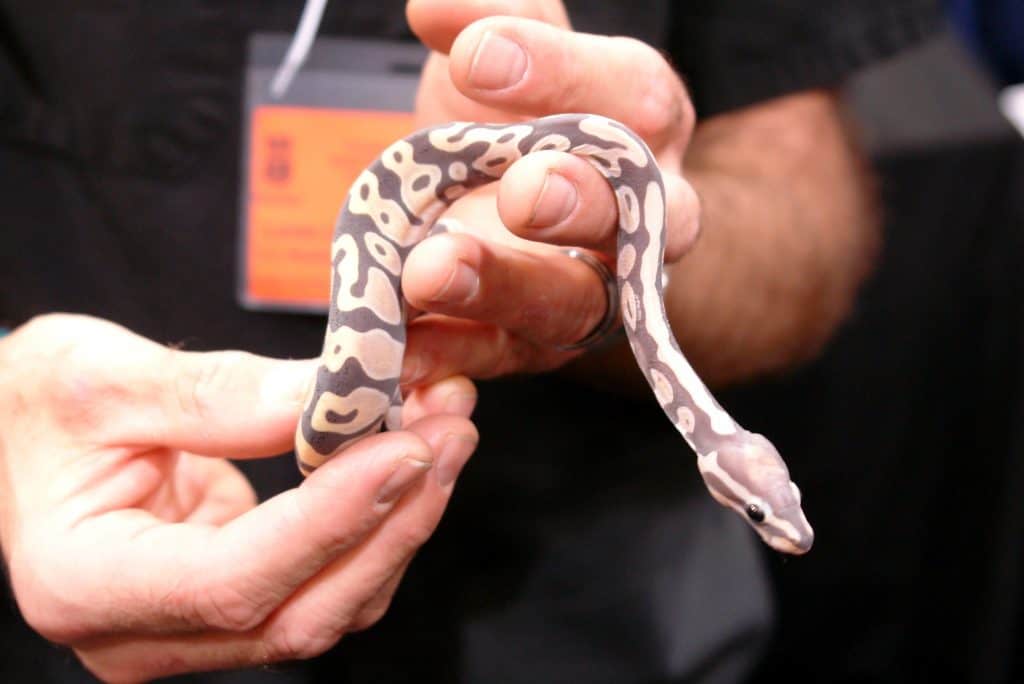
Image credit: u/LLLReptile (via Reddit.com)
The lack of scales is an extremely rare recessive gene.
BHB revealed the first scaleless ball pythons in 2013.
Today, they’re one of the rarest ball python morphs on the market.
Ball pythons weren’t the first scaleless snakes that breeders produced in the pet trade.
The most popular scaleless snake species include corn snakes, Texas rat snakes, and garter snakes.
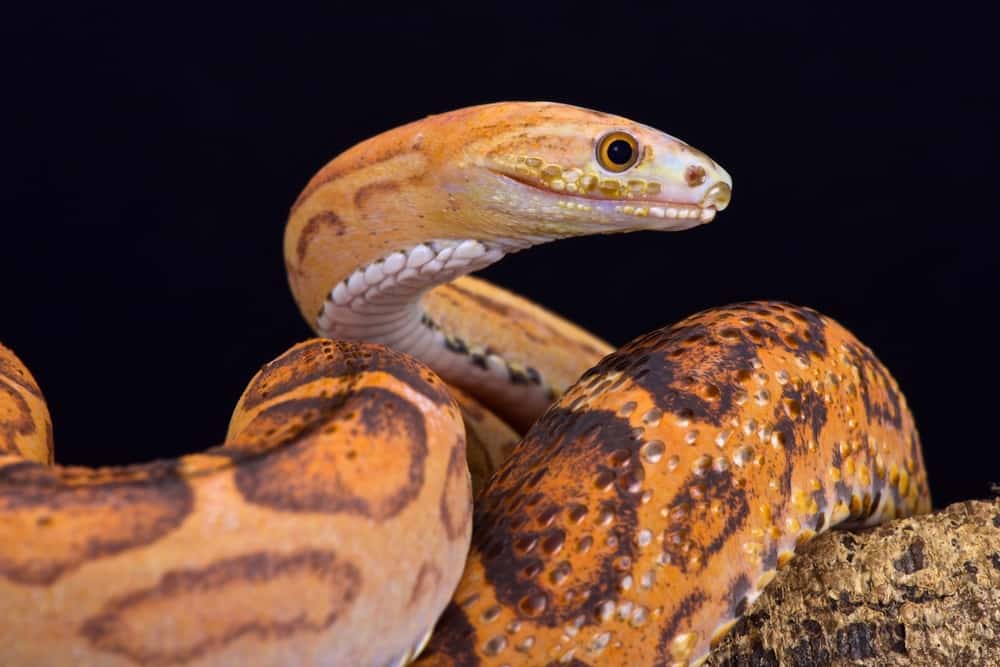
There’s a substantial amount of controversy surrounding the existence of scaleless snakes as pets, especially scaleless ball pythons.
Opinions on their ethicality vary widely amongst reptile enthusiasts.
Some keepers say that scaleless ball pythons are inhumane because of their lack of ventral scales, shedding issues, and lack of heat pits.
Others claim that scaleless ball pythons are morphs just like any other. They can move fine without ventral scales, shed with little assistance, and can sense heat without a physical ‘pit.’
We fully understand and acknowledge the debate and respect everyone’s insights and opinions.
Our goal is to provide you with an ethical and comprehensive care guide for these unique pets without bias.
Why Won’t My Ball Python Eat?
Ball pythons are notoriously picky eaters, and scaleless ball pythons are no different.
Don’t worry! Ball pythons fast for beginner and experienced keepers alike.
Your snake may not be eating for several reasons:
| Illness |
Loss of appetite is often one of the first signs that your snake is sick. It can be as mild as constipation or as severe as respiratory problems. Don’t panic and rush your snake to the veterinarian every time it stops eating. Monitor them for more symptoms. |
| Brumation |
Your snake could be going into brumation, a reptile’s version of hibernation. During brumation, they stop eating for months to survive through winter. Your snake doesn’t need to worry about winter in its enclosure, but it’s an instinct that’s hard to get rid of. |
| New food item |
A snake can become accustomed to a particular type of prey. If you’re trying to introduce a new prey item into your snake’s diet, it may not realize it’s something to eat. This occurrence is common when switching from live or freshly killed prey to frozen prey, or from mice to rats. Always ask the previous owner what type of prey they fed and how they fed your snake. Sometimes consistency is key. |
| They feel stressed |
Certain factors can cause your snake to feel too stressed to eat. Overhandling, moving, feeling exposed, or environmental disturbances can increase stress. |
| They’re about to shed |
Most snakes won’t eat while going into a shed cycle. Just wait until they’ve shed completely before offering food. |
| It’s the wrong time of day |
If you’re feeding during the day, try switching to night-time meals. These snakes are nocturnal in the wild and often retain that behavior in captivity. |
|
Incorrect temperature and humidity levels |
If the temperature in your snake’s enclosure isn’t high enough, they can have problems digesting their food and won’t want to eat. Low humidity levels can lead to dehydration, stress, and illness. |
It can be discouraging to see your snake stop eating.
Don’t lose hope!
There are several techniques you can try to get your python to eat:
- Give your snake more time.
- Leave the prey with your snake overnight. If it doesn’t eat it right away, it may need more privacy.
- Warm up frozen prey in hot water.
- Increasing the temperature of a frozen-thawed prey item can make it more natural and desirable.
- Try ‘braining’ or scenting the prey.
- Braining means opening the prey’s skull, which can be difficult for new owners to stomach. The smell can trigger a feeding response.
- If you’re attempting to switch prey items, you can try rubbing them together to transfer scents. For example, when moving from frozen mice to rats, thaw them in the same bag and rub them together so that your snake smells its familiar prey on the new one.
- Use different types and sizes of prey.
- If your snake isn’t interested in frozen-thawed prey items, you may need to try pre-killed.
- Live prey should be your absolute last resort for your scaleless ball python.
We recommend keeping a detailed feeding log for your snake. It will help you keep track of how often it’s eating, which prey items it likes, and which feeding techniques worked best.
You can also record how often your snake is pooping and any other health or behavioral symptoms you may notice.
A detailed record will be extremely useful for your veterinarian if you need to visit one.
Do Scaleless Ball Pythons Make Good Pets?
All ball pythons make great pets!
They’re easy to care for, affordable, and come in hundreds of different morphs.
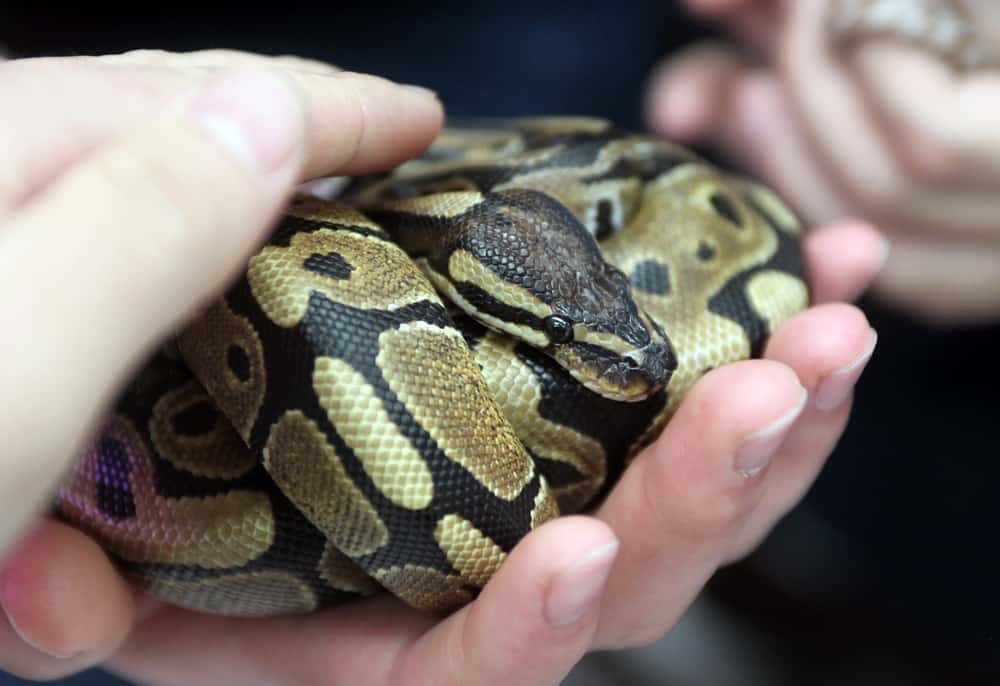
While regular ball pythons are the perfect beginner snake, scaleless ball pythons are slightly more advanced.
Because of their special requirements, we don’t recommend them as first-time pets.
Scaleless ball pythons are a great fit for someone with a little more experience keeping snakes.
Do Scaleless Snakes Shed?
Yes, scaleless snakes shed!
All snakes shed. They aren’t shedding scales but an outer layer of skin as they grow.
Unlike regular snake sheds, scaleless snake sheds are smooth and don’t show a snake’s patterns.
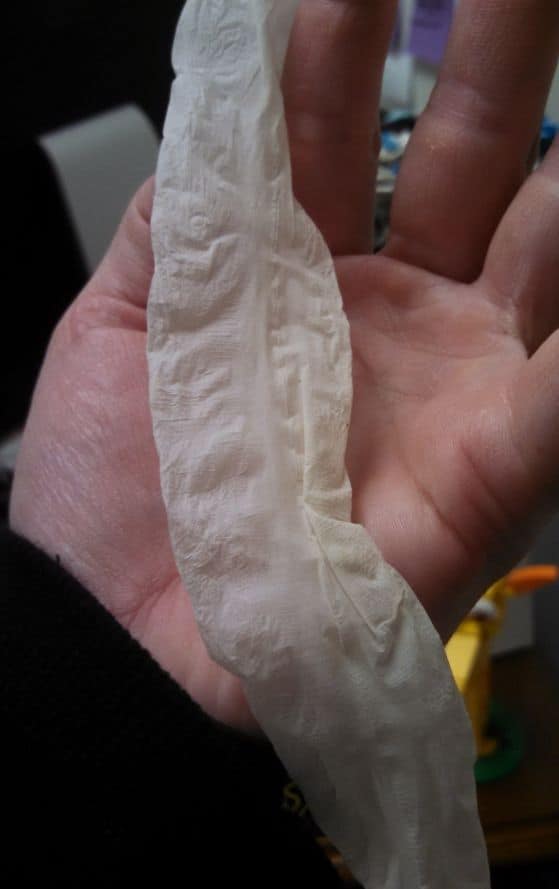
Image credit: u/tdgonex (via Reddit.com)
Scaleless ball pythons tend to shed more frequently than regular ball pythons.
They’re also more prone to shedding problems.
Are Scaleless Ball Pythons Healthy?
Scaleless ball pythons and other scaleless snakes are healthy.
They’re quite the controversy in the reptile community.
Many reptile enthusiasts feel that snakes without scales are unnatural.
Although extremely rare, the lack of scales is a recessive gene that can occur naturally.
We’ve been finding scaleless snakes healthy and surviving in the wild for decades.
The foremost uncertainty with fully scaleless ball pythons is how they age.
Because they’ve only been around since 2013, we can’t be sure if they have the same longevity as regular ball pythons.
Ball pythons live 20-30 years in captivity.
We hope you enjoyed this guide on scaleless ball pythons!
Have you ever heard of a scaleless snake before? Let us know in the comments below!
